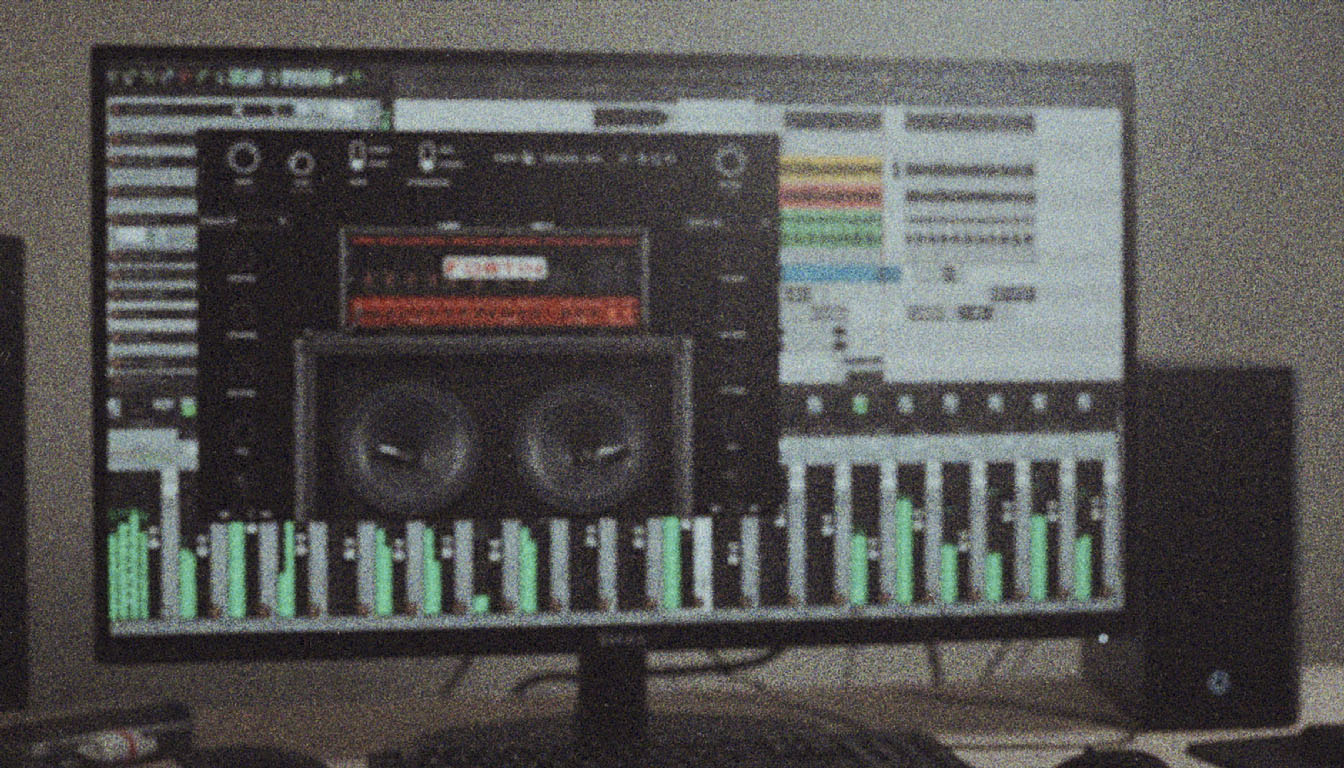
Music Dynamics: the defining characteristic of modern metal?
Nail The Mix Staff
Modern metal hits DIFFERENT. That earth-shattering breakdown after a frantic blast beat? That sudden, impactful silence before the riff kicks back in? That’s the power of music dynamics, and frankly, it's one of the defining features that separates today's brutal, polished productions from the metal of yesteryear. If your mixes are feeling flat, static, or just not delivering that gut-punch impact, mastering music dynamics is probably the missing piece.
Forget just "loud vs. quiet." We're talking about the lifeblood of a track, the push and pull that keeps listeners on the edge of their seats. And in a world where bands like Lorna Shore can drop "To The Hellfire" with its insane dynamic shifts from orchestral beauty to demonic obliteration, the bar is set incredibly high. The good news? You’ve got the tools, and we’re about to dive into how to use them.
What ARE Music Dynamics in Modern Metal, Anyway?
At its core, music dynamics refers to the variations in loudness within a piece of music. But for us metal producers, it’s way more nuanced than that. We’re dealing with a genre that’s inherently loud and dense. So how do we carve out space for dynamics?
- Macro Dynamics: This is the big picture stuff – the difference in intensity between your verse and your chorus, your build-up and your breakdown, or that quiet interlude versus the full-band onslaught. Think of the journey a song like Spiritbox's "Holy Roller" takes you on; that's macro dynamics at play.
- Micro Dynamics: These are the smaller, moment-to-moment changes. The attack of a snare hit, the decay of a cymbal, the subtle swell of a guitar riff, or the way a vocalist emphasizes certain words. Modern production, with its sample-replaced drums (shoutout to GetGoodDrums or Superior Drummer 3) and meticulous editing, allows for insane precision here.
- Arrangement is King: Often, the most powerful dynamics are written into the song. A sudden stop, a change in instrumentation (like dropping out guitars for a drum and vocal section), or a shift in rhythmic density.
- Performance Matters: Even with all the studio magic, a killer performance imbued with natural dynamics provides the best foundation. A drummer who knows when to hit hard and when to lay back, or a guitarist who can vary their picking intensity, makes your job in the mix ten times easier.
The modern metal audience expects that hyper-polished sound, and effective dynamics are a massive part of that. It’s not just about being loud; it’s about being impactful.
Why Modern Metal DEMANDS Extreme (and Controlled) Dynamics
Back in the day, a lot of metal was pretty consistently loud. The dynamic range wasn't always a primary focus, especially in some of the more raw subgenres. But today? It’s a different ball game.
The expectation for sonic perfection, even from smaller bands, is through the roof. And part of that perfection is the skillful use of dynamics to create an emotional rollercoaster. Think about the sheer contrast in a track like Lorna Shore’s “To The Hellfire” – the chaotic, dense blast beats suddenly giving way to an earth-shatteringly heavy, spacious breakdown. That contrast is what creates the impact. Without those dynamic shifts, it just wouldn’t hit the same.
This ties into how modern metal draws from so many other genres. Pop, EDM, even hip-hop often utilize dramatic dynamic shifts for hooks and drops. As metal incorporates these influences (think Falling in Reverse or Bring Me The Horizon's genre-bending antics), sophisticated dynamic arrangements become crucial.
But here's the catch: these extreme dynamics need to be controlled. Sloppy dynamics sound amateurish. The polish comes from making those transitions clean, powerful, and intentional. This is where your production chops really shine.
Sculpting Dynamics: Arrangement & Performance First
Before you even touch a fader or a plugin, the groundwork for killer dynamics is laid in the songwriting and performance.
- Songwriting for Impact: Encourage bands to think dynamically. Does every section need to be full throttle? Where can you create space? Could a stripped-down pre-chorus make the chorus hit even harder? Consider how bands like Periphery use complex rhythmic change-ups and textural shifts to build and release tension.
- The Human Element: Modern musicianship is insane. Drummers can play with incredible precision and power, executing intricate ghost notes and explosive accents. Guitarists using gear like Neural DSP amp modelers can dial in tones that respond beautifully to picking dynamics. Capture this! A great performance with built-in dynamics is gold. Don't be afraid to coach musicians to emphasize certain sections or back off in others.
- Instrumentation Choices: Sometimes, the most effective dynamic shift is simply removing elements. Dropping the rhythm guitars and bass for a beat to let a vocal hook or a drum fill shine can create immense impact when everything slams back in.
Taming the Beast: Mixing for Maximum Dynamic Impact
Okay, you've got a well-arranged song with a dynamic performance. Now it's time to enhance and control those dynamics in the mix.
H3: Automation: Your Best Friend for Macro Dynamics
Volume automation is your #1 tool for shaping the overall dynamic contour of your song. Don't just set it and forget it!
- Riding Faders: Manually automate the volume of individual tracks, buses (like your drum bus or guitar bus), and even the master fader.
- Example: Slightly pull down rhythm guitars during verses to make vocals clearer, then push them up for the chorus. Automate cymbal swells into transitions. Dip the master fader by a dB or two just before a huge impact to make it feel even bigger.
- DAW Power: Whether you're in Pro Tools, Reaper, Logic Pro X, or Cubase, get intimate with your automation lanes. Use different automation modes (touch, latch, write) to find what works best for your workflow.
- Filter Automation: Don't just think volume. Automating a high-pass filter on guitars to thin them out in a verse, then opening it up for the chorus, can create a massive sense of dynamic expansion.
H3: Compression: Shaping, Not Squashing (Unless You Want To)
Compression is often misunderstood as just a tool to make things louder. In reality, it's a powerful dynamic shaping tool. (For a deeper dive, check out our Metal Compression Secrets Beyond Just Making It Loud hub page).
- Punch and Glue:
- Snare: A fast FET compressor like a UAD 1176 Rev E (or a quality plugin emulation like the Waves CLA-76) with a fast attack and release can add serious smack and consistency. Try settings like Attack: 5-6, Release: 7 (fastest), Ratio: 4:1, and aim for 3-6dB of gain reduction on peaks.
- Drum Bus: An SSL-style bus compressor (like the Waves SSL G-Master Bus Compressor or the one built into many SSL consoles/plugins) with a slow attack (10-30ms), fast release (0.1-0.3s), and low ratio (2:1 or 4:1) can glue your drums together and enhance their groove. Aim for 2-4dB of gain reduction.
- Parallel Compression: Blend a heavily compressed signal (think Empirical Labs Distressor on "Nuke" or a FabFilter Pro-C 2 slammed hard) with your dry signal. This adds sustain and power without sacrificing all your transients. Awesome on drums, bass, and even vocals.
- Taming Peaks: For instruments with unruly peaks (like aggressive vocals or a pokey bass), a transparent compressor can gently level things out, making them easier to sit in the mix and allowing other elements to breathe.
H3: Gating & Expansion: Creating Space and Accentuating Hits
Noise gates and expanders are crucial for cleaning up your mix and enhancing dynamic contrast, especially with live drums or high-gain guitars.
- Cleaning Up Drums: Use a gate like FabFilter Pro-G or the classic Waves C1 Gate on toms and kick to remove bleed and tighten up the sound. Set the threshold carefully and use the hold and release controls to avoid choppy tails.
- Adding Snap: An expander can be used to increase the dynamic range. For example, on a snare, you can set it to expand the initial transient, making it hit even harder while reducing the level of the sustain/ring if needed.
- Creating Separation: Gating can create silence between notes on chuggy, palm-muted guitars, making rhythmic passages incredibly tight and impactful. Think about the percussive precision of bands like Meshuggah – gating plays a role there.
H3: EQ: Enhancing Dynamic Contrast
EQ isn't just for tone shaping; it's a dynamic tool too! (Explore more on our Carve Your Core: EQ Strategies for Mixing Modern Metal hub page).
- Dynamic EQ: Plugins like FabFilter Pro-Q 3 or Waves F6 Floating-Band Dynamic EQ are game-changers. They allow you to cut or boost frequencies only when they exceed a certain threshold.
- Example: Tame harsh cymbal resonances only when they're hit hard, or control boomy low-end on palm mutes without thinning out the overall guitar tone.
- Automated EQ: Automate EQ changes between sections. For a quieter verse, you might roll off more low-end from guitars and bass to create space, then bring it back for a massive chorus.
- Contrast is Key: If a section is meant to be huge and wide, ensure the preceding section is perhaps a bit narrower or more focused in the midrange. Then, when the big section hits, the perceived dynamic shift is enormous.
H3: Saturation & Distortion: Adding Perceived Loudness and Excitement
Sometimes, you want something to feel louder and more intense without actually eating up more headroom. Enter saturation.
- Harmonic Richness: Plugins like FabFilter Saturn 2, Soundtoys Decapitator, or even a subtle guitar amp sim can add harmonics that make a sound cut through and feel more energetic.
- Selective Application: Try light saturation on a drum bus to add grit and cohesion, or on vocals to help them stand out without aggressive EQ boosts. Even a touch on the master bus can add excitement.
- Warning: A little goes a long way. Overdo it, and you’ll just have a fuzzy, undynamic mess. The goal is controlled excitement.
The Loudness War vs. True Dynamics: Finding the Balance
Yes, modern metal is LOUD. The expectation for a competitive master is real. But this doesn't mean you have to squash every last bit of dynamic range out of your mix. In fact, a mix with well-managed dynamics will often sound louder and more impactful at the same LUFS level than a brickwalled one.
- Reference Tracks: Constantly compare your mix to pro releases in similar subgenres. Pay attention not just to their overall loudness, but how they use dynamics to create impact.
- Headroom is Your Friend: Leave some headroom during mixing. This gives the mastering engineer room to work their magic without having to fight an already over-compressed mix.
- The Polish Factor: Remember that highly polished sound everyone expects? Part of that is clarity and punch, which comes from preserving transients and dynamic relationships, not just slamming everything into a limiter.

100+ Insanely Detailed Mixing Tutorials
We leave absolutely nothing out, showing you every single step
Case Study: Dissecting Dynamics in "To The Hellfire"
Let's go back to Lorna Shore's "To The Hellfire." This track is a masterclass in modern metal dynamics.
- Orchestral Intros/Outros: Massive dynamic swells, setting a cinematic tone.
- Blast Beats: Insanely tight and precise, often courtesy of sample augmentation/replacement (Superior Drummer 3 is a popular choice for this level of detail) and meticulous editing. The consistency here makes the absence of sound even more dramatic.
- The Silence Before the Drop: Those moments of near silence, often punctuated by a single cymbal choke or vocal gasp, before a colossal breakdown hits. This is pure dynamic tension and release.
- Breakdowns: Often feel MONSTROUSLY heavy, partly due to the contrast with preceding sections, but also because every element (super-low tuned guitars, sub-heavy kick, impactful snare) is perfectly placed and hits with maximum weight. Automation is key here, ensuring every cymbal hit, every guitar chug, has its space and power.
- Vocal Dynamics: Will Ramos's vocal performance is incredibly dynamic, shifting from guttural lows to piercing highs, often with sudden changes in intensity and timbre. The mix supports this, ensuring every nuance is audible and impactful.
The precision offered by modern drum programming/sampling and editing is what allows these extreme dynamic shifts to sound so polished and deliberate, rather than just chaotic.
Nail The Mix: Learn How the Pros Craft Killer Dynamics
Want to see exactly how Grammy-winning producers sculpt these kinds of dynamics in real-world sessions? That's what Nail The Mix is all about. Every month, you get the actual multi-tracks from a massive metal song and watch the original producer mix it from scratch, explaining every plugin, every fader move, and every decision they make – including how they use automation, compression, EQ, and more to create those hard-hitting, dynamic mixes.
If you're serious about taking your modern metal productions to the next level and truly understanding how to harness the power of dynamics, check out Nail The Mix and Unlock Your Sound: Mixing Modern Metal Beyond Presets.
It’s All About the Impact
Music dynamics are far more than a technical detail; they are the emotional engine of your modern metal tracks. By understanding how to write for them, perform them, and then enhance them in the mix using tools like automation, compression, EQ, and saturation, you can transform your productions from merely loud to truly monumental. The bar for production quality is higher than ever, but so are the resources available to learn. So dive in, experiment, and make your mixes hit harder than ever before.
Get a new set of multi-tracks every month from a world-class artist, a livestream with the producer who mixed it, 100+ tutorials, our exclusive plugins and more
Get Started for $1





